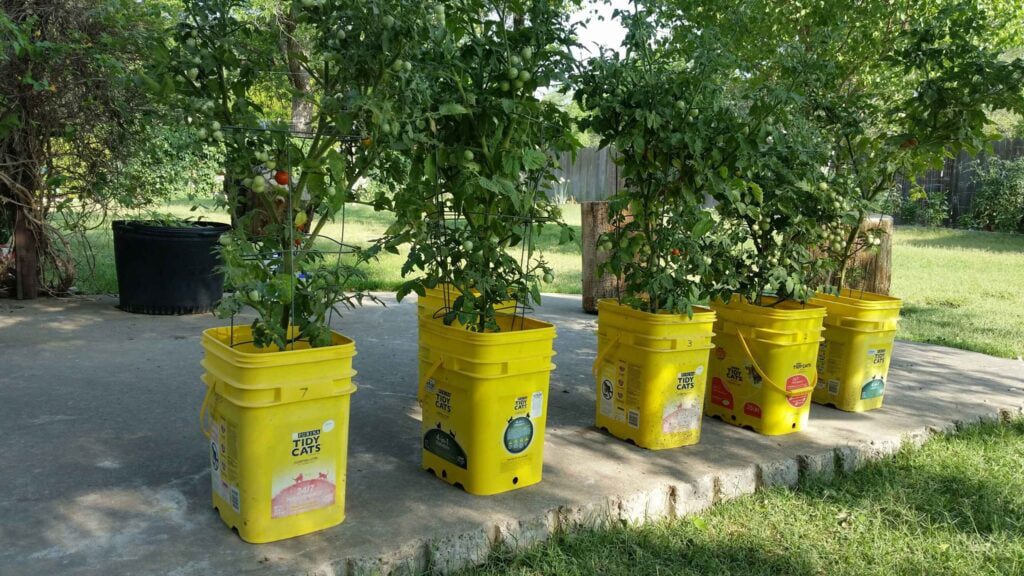
Growing tomatoes in buckets offers a versatile and space-saving solution for avid gardeners and urban dwellers alike. To ensure a successful harvest, it’s crucial to find the best way to grow tomatoes in buckets while maximizing yield. In this comprehensive guide, we will explore a range of creative techniques, expert tips, and frequently asked questions to help you unlock the full potential of your tomato plants in buckets. Get ready to discover how to achieve bountiful yields in a compact space.
This post may have affiliate links. This means that sometimes when you click a link on our site and make a purchase on Amazon, we may earn a small commission at no additional cost to you. We only recommend products we truly believe in, and your support helps keep us running!
Table of Contents
Choosing the Right Buckets and Soil For The Best Way to Grow Tomatoes in Buckets
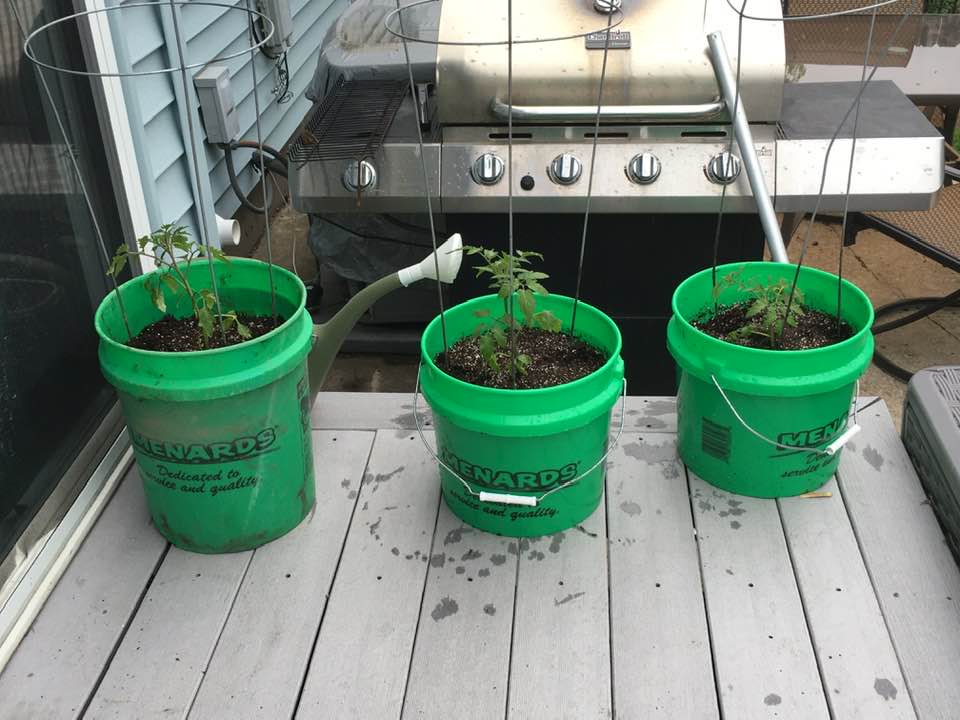
When it comes to growing tomatoes in buckets, two critical factors play a significant role in the success of your garden: choosing the right bucket and selecting the ideal soil mix. These considerations are key to ensuring healthy tomato growth and a bountiful harvest. Let’s dive into the details and explore the best way to approach each aspect of bucket gardening for tomatoes.
Selecting the Appropriate Bucket Size:
The first step in setting up your bucket garden is to pick the right size containers for your tomato plants. While bigger buckets might seem tempting for more room, finding the perfect balance is crucial. Many experienced gardeners recommend starting with 5-gallon buckets, which serve as an excellent foundation for your tomato plants.
Why 5-gallon buckets, you may wonder? Well, this size offers ample space for the tomato’s root system to flourish without risking excessive moisture retention in the soil. When roots have the right environment to grow and expand, your tomato plants will thrive, resulting in healthier and more productive yields.
Finding the Ideal Soil Mix for Tomato Growth:
Now that you’ve got your buckets sorted, it’s time to turn your attention to the soil. Traditional garden soil might not be the best option for container gardening, as it can become compacted and hinder root growth. Instead, opt for a well-balanced and nutrient-rich soil mix.
One popular and effective soil mix for bucket-grown tomatoes includes a combination of peat moss, perlite, and compost. This blend not only provides the necessary nutrients for your plants but also ensures proper drainage. Good drainage is essential to prevent waterlogging, which can lead to root rot and other plant issues. Remember, a well-draining soil mix is a key ingredient in the recipe for healthy tomato plants.
As you embark on your bucket gardening journey, keep these considerations in mind. Selecting the right bucket size and soil mix will set the stage for your tomato plants to flourish and bear fruit abundantly.
Ensuring Proper Drainage for Healthy Roots
In the realm of bucket gardening, ensuring proper drainage is an essential aspect for maintaining healthy tomato plants with robust root systems. To safeguard against waterlogging and root rot, it’s crucial to have drainage holes at the bottom of your buckets. These tiny escape routes allow excess water to flow out, maintaining the perfect moisture balance vital for your tomato plants’ well-being.
The secret to successful drainage lies in the strategic placement of these holes. When drilling or creating them, make sure they are evenly distributed around the base of the bucket. This arrangement ensures that water doesn’t collect in one spot, but instead evenly seeps out, benefiting the entire root system.
Additionally, consider elevating your buckets slightly by placing them on bricks or blocks. This simple technique further enhances drainage and prevents the buckets from sitting in standing water, which could be detrimental to the roots.
Selecting the Perfect Tomato Varieties for Bucket Gardening
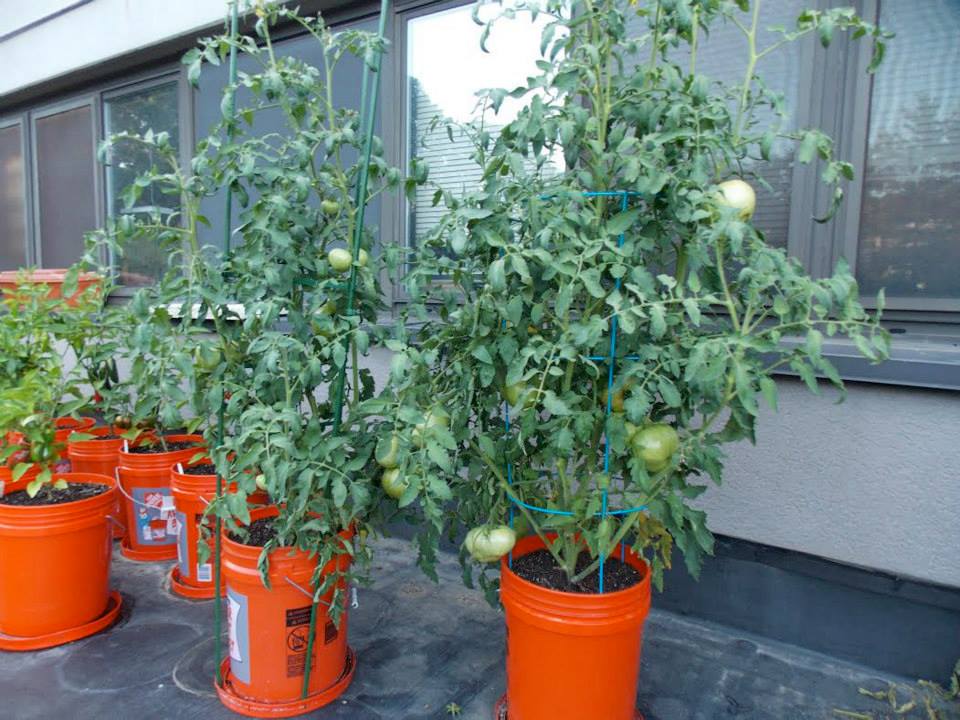
Selecting the perfect tomato varieties is crucial for successful container growth in buckets. Not all tomatoes are created equal, and certain varieties are better suited for thriving in containers. Let’s explore how to determine the best tomatoes for your bucket garden.
Determining the Best Tomatoes for Container Growth:
- Consider Compact Varieties: Look for tomato varieties specifically bred or known for their compact growth habit. These varieties typically have a more restrained size, making them ideal for container gardening. Look for terms like “dwarf,” “patio,” or “bush” in the variety’s name or description.
- Indeterminate vs. Determinate: Understand the difference between indeterminate and determinate tomato varieties. Indeterminate tomatoes keep growing and producing fruit throughout the season until frost hits. While they can be grown in containers, they require larger and sturdier support structures. Determinate tomatoes, on the other hand, have a more compact size and tend to produce a bountiful harvest within a defined period. They are generally easier to manage in containers.
- Consider Flavor and Purpose: Think about the flavor profile you desire and how you plan to use the tomatoes. Do you prefer sweet and juicy tomatoes for fresh eating, or are you looking for varieties that are ideal for sauces and canning? Research the flavor characteristics and recommended uses of different tomato varieties to find the ones that align with your preferences.
- Disease Resistance: Check for disease-resistant varieties. Some tomato varieties are bred to be resistant to common diseases, such as blight or fusarium wilt. Choosing disease-resistant varieties can help safeguard your plants and ensure a successful harvest.
Selecting the right tomatoes will set the stage for a fruitful and rewarding bucket gardening experience.
Exploring Compact Varieties Ideal for Buckets
Exploring compact tomato varieties is an exciting venture. These petite powerhouses are ideal for growing in containers and can bring a burst of flavor to your garden without taking up much space.
Compact tomatoes, often referred to as dwarf or bush varieties, are specially bred to have a more restrained growth habit. Unlike their sprawling counterparts, these little wonders stay relatively small and tidy, making them perfect candidates for container gardening.
The Advantages of Compact Varieties for Buckets
- Space-Saving Marvels: One of the most apparent benefits of compact tomatoes is their ability to thrive in limited spaces. Whether you have a small balcony, patio, or even a sunny windowsill, these tomatoes can fit right in and make the most of the available area.
- Easy to Manage: Due to their smaller size, compact tomato varieties are easier to manage and care for in containers. You won’t need elaborate staking or support systems, saving you time and effort in the garden.
- Bountiful Yields: Don’t let their size fool you – compact tomatoes are known for their generous yields. You’ll be amazed at how many delicious fruits these little plants can produce throughout the growing season.
- Flavorful Delights: Compact tomato varieties are prized for their exceptional taste and sweetness. Despite their diminutive size, they deliver big on flavor, making them a delightful addition to your culinary creations.
Popular Compact Tomato Varieties for Bucket Gardening
- Tiny Tim: A true miniature marvel, Tiny Tim produces cherry-sized tomatoes packed with sweetness and flavor. Its compact size and vibrant red fruits make it a favorite for small-space gardening.
- Tumbling Tom: This cascading variety is perfect for hanging baskets or containers. Tumbling Tom produces small, tangy tomatoes that dangle beautifully from the plant, adding a unique touch to your bucket garden.
- Patio Princess: As the name suggests, Patio Princess is a true royalty in the world of compact tomatoes. With its early maturing and delectable fruits, it’s a must-have for any container gardener.
- Bush Early Girl: This determinate variety offers an early harvest and compact growth, making it an excellent choice for bucket gardening. Its rich, classic tomato flavor will satisfy your taste buds.
Exploring compact tomato varieties for your bucket garden is a fantastic way to embrace the beauty of small-space gardening. These space-saving wonders offer bountiful yields, exceptional flavors, and ease of management, making them the ideal companions for your bucket gardening journey. So, grab your containers, fill them with nutrient-rich soil, and get ready to savor the delights of these little tomato treasures.
Considering Indeterminate vs. Determinate Tomatoes
When it comes to the best way of growing tomatoes in buckets, considering the difference between indeterminate and determinate tomatoes is essential for a successful gardening experience. Understanding these two categories will help you make informed decisions and choose the best tomato varieties for your bucket garden. Let’s explore the characteristics of indeterminate and determinate tomatoes and how they can influence your gardening plans.
Indeterminate Tomatoes:
- Thriving for the Long Haul: Indeterminate tomatoes are known for their continuous growth throughout the growing season. Unlike determinate varieties, indeterminate tomatoes do not have a predetermined endpoint for fruit production. Instead, they keep growing, flowering, and producing tomatoes until the first frost arrives.
- Space and Support: Due to their continuous growth and potentially tall stature, indeterminate tomatoes require ample space and sturdy support structures. When grown in buckets, it’s essential to use large containers and provide appropriate staking or trellising to support the plants as they reach for the sky.
- Extended Harvest:The advantage of indeterminate tomatoes is their extended harvest period. They continually produce new tomatoes, allowing you to enjoy fresh fruit throughout the growing season.
Determinate Tomatoes:
- Productivity with a Timeline:Determinate tomatoes, on the other hand, have a predetermined endpoint for fruit production. These varieties tend to grow to a specific height and produce fruit within a relatively short window of time.
- Compact and Manageable: The compact growth habit of determinate tomatoes makes them more suitable for container gardening. They don’t require extensive staking or trellising, making them easier to manage in buckets.
- Synchronized Harvest: Determinate tomatoes offer a more synchronized harvest. Since their fruit production is concentrated within a specific period, you can expect a large yield all at once, which can be advantageous for preserving or processing the tomatoes.
When choosing between indeterminate and determinate tomatoes for your bucket garden, consider your space, support capabilities, and harvest preferences. If you have ample space and the means to provide support, indeterminate varieties can offer a more extended and continuous harvest. On the other hand, if space is limited and you prefer a more synchronized harvest, determinate varieties may be the better option.
Essential Tips For the Best Way To Grow Tomatoes In Buckets
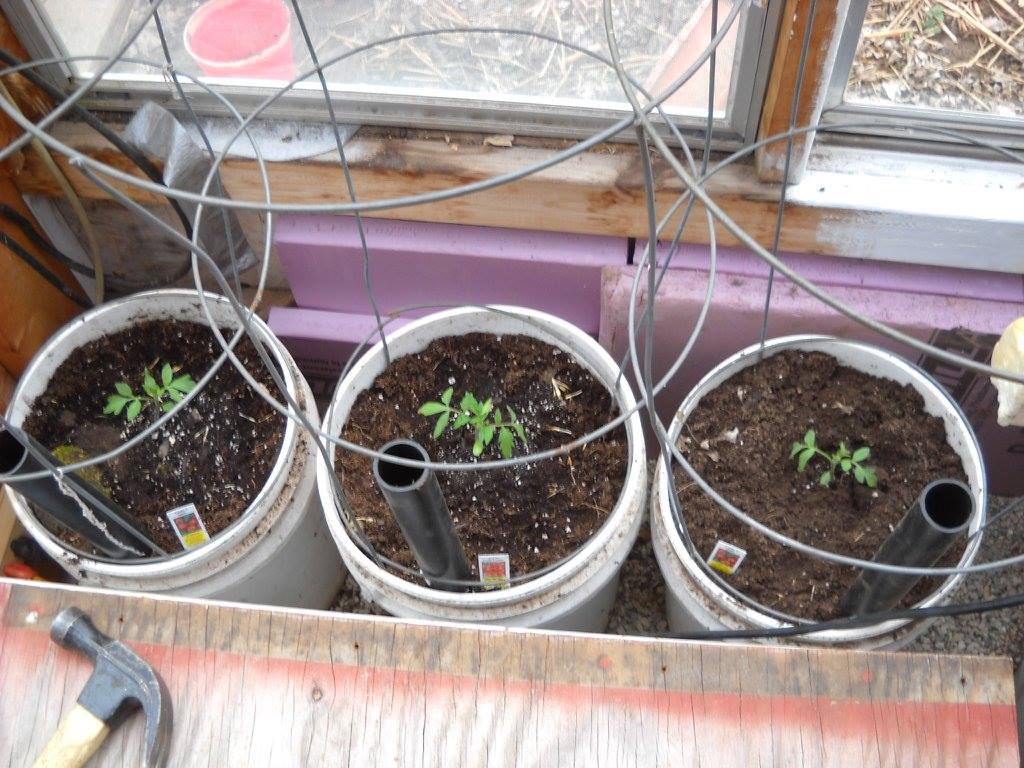
Providing adequate sunlight and maintaining the right temperature are two crucial factors that can greatly impact the growth and productivity of your tomato plants. Let’s explore these essential tips to ensure your tomatoes thrive in their bucket home.
Providing Adequate Sunlight

Tomatoes are sun-loving plants, and ample sunlight is vital for their growth and fruit production. When choosing a location for your bucket garden, aim for a spot that receives at least 6 to 8 hours of direct sunlight per day. Placing your buckets in a sunny location allows the plants to soak in the sun’s energy and develop strong, healthy foliage.
Positioning Tomato Plants In Buckets
To maximize sunlight exposure, carefully position your buckets to face south or southwest, as these directions typically receive the most sunlight throughout the day. Avoid placing the buckets in the shadow of tall structures or trees that may obstruct the sun’s rays.
Adjusting for Shade
If your outdoor space doesn’t receive full sunlight for the recommended hours, don’t worry! Tomatoes can still grow in partial shade, but they may not be as productive as those in full sun. If possible, try to provide at least 4 to 6 hours of direct sunlight to ensure decent tomato yields.
Maintaining the Right Temperature
Tomatoes thrive in warm temperatures, but extreme heat can be challenging for them to handle. Aim for daytime temperatures between 70°F to 85°F (21°C to 29°C) for optimal growth. At night, temperatures between 60°F to 70°F (15°C to 21°C) are preferable.
Protecting from Extremes
During heatwaves or scorching summer days, consider providing some shade or shelter for your tomato plants. You can use umbrellas, shade cloths to protect tomatoes from intense sunlight and extreme temperatures.
Watch for Cold Snaps
On the other hand, if temperatures drop unexpectedly, be prepared to cover your plants overnight to protect them from cold snaps. Frost can be detrimental to tomato plants, so it’s essential to shield them from chilly temperatures.
Ensuring your tomato plants receive adequate sunlight and maintaining the right temperature will contribute to healthy growth and abundant yields. With a little attention to these critical factors, your bucket garden will be teeming with vibrant and fruitful tomato plants.
Planting Techniques for Optimal Growth

Employing the right techniques can significantly impact the optimal growth and overall success of your bucket garden. From preparing the buckets to planting the tomato seedlings, let’s explore the essential planting techniques to ensure your tomatoes thrive and flourish.
Choosing the Right Seedlings
Selecting healthy and robust seedlings is the first step towards optimal growth. Look for seedlings with sturdy stems, vibrant green leaves, and no signs of disease or pests. Avoid leggy or spindly seedlings, as they may struggle to establish themselves.
Preparing the Buckets
Before planting, ensure your buckets are clean and have adequate drainage holes at the bottom. Rinse the buckets thoroughly and let them dry before filling them with the ideal soil mix.
Adding the Soil Mix
Fill each bucket with the well-draining soil mix you’ve prepared. Leave about an inch of space below the rim to allow for easy watering and prevent soil from spilling over.
Planting the Tomato Seedlings
- Digging the Holes: Create small holes in the soil mix, deep enough to accommodate the root ball of each seedling.
- Planting Depth: When placing the seedlings in the holes, bury them slightly deeper than they were in their nursery containers. This allows for better root development and sturdier plants.
- Removing Lower Leaves: Before planting, remove the lower leaves of the seedlings. This helps prevent soil-borne diseases and encourages the growth of new roots along the stems.
- Firming the Soil: Gently firm the soil around each seedling to ensure good soil-to-root contact. Avoid compacting the soil excessively, as it may hinder water drainage.
Watering Techniques
- Initial Watering: After planting, give the seedlings a thorough watering to settle the soil and hydrate the roots.
- Watering Frequency: Tomatoes in buckets may require more frequent watering than those in the ground. Check the soil regularly and water whenever the top inch feels dry.
- Watering Deeply: When watering, ensure the water reaches the root zone by watering deeply and evenly across the surface of the soil.
Mulching Benefits
Applying a layer of organic mulch around the base of the seedlings can be beneficial. Mulch helps retain moisture, regulates soil temperature, and suppresses weeds, contributing to healthier and more productive tomato plants.
Staking and Supporting Tomato Plants in Buckets
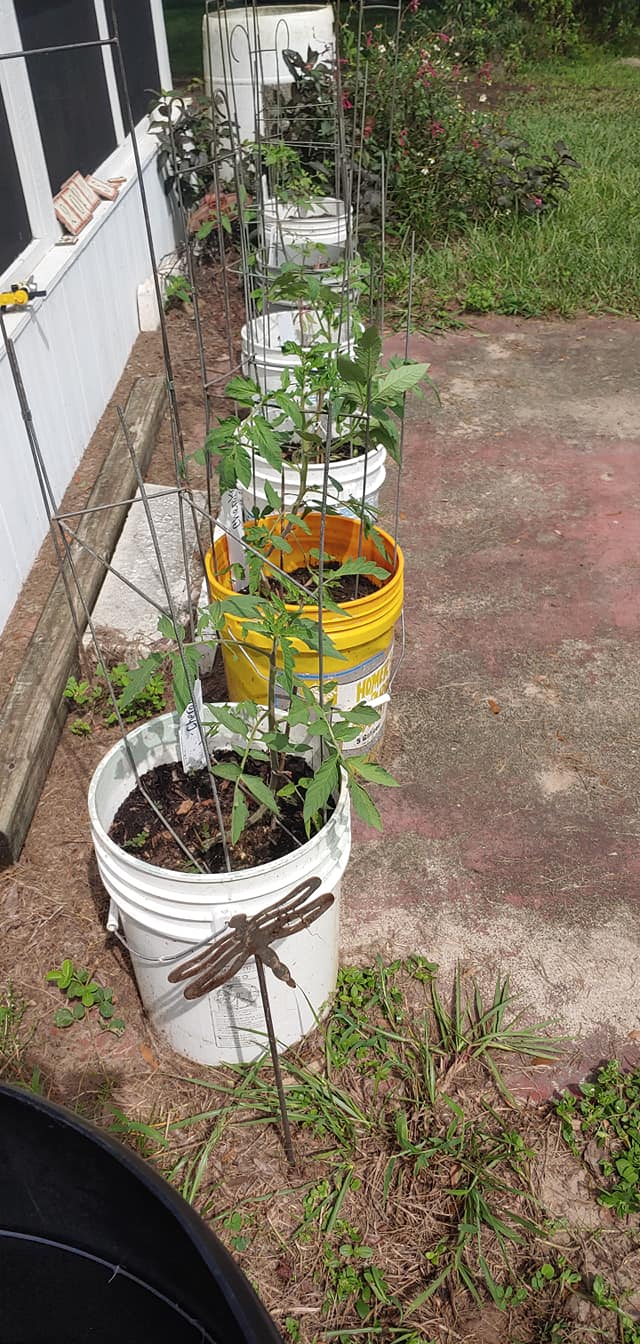
Staking and supporting tomato plants in buckets is a crucial step in ensuring their upright growth, preventing breakage, and maximizing fruit production. As your tomato plants grow, they will need reliable support structures to keep them steady and thriving. Let’s explore the essential techniques for staking and supporting your tomato plants in buckets to achieve a successful and fruitful garden.
When to Stake Tomato Plants In Buckets
Staking your tomato plants should be done shortly after transplanting them into the buckets. By providing support early on, you encourage the plants to grow vertically and prevent them from sprawling on the ground, where they are more susceptible to disease and pests.
Choosing the Right Stakes or Supports
Several options are available for staking tomato plants in buckets:
- Sturdy Wooden Stakes: Wooden stakes are a classic choice for supporting tomato plants. Choose stakes that are at least 5 to 6 feet tall to accommodate the height of your mature tomato plants.
- Tomato Cages: Tomato cages are convenient and easy to use. They are available in various sizes, and you can choose cages with wider spacing for larger varieties or closer spacing for compact varieties.
- DIY Supports: Get creative and make your own supports using materials like bamboo sticks, PVC pipes, or wire cages.
How to Stake Tomato Plants In Buckets
- Inserting the Stakes: Place the stakes or supports into the buckets when transplanting your tomato seedlings. Push them firmly into the soil, ensuring they are stable and won’t wobble.
- Securing the Plants: As the tomato plants grow, gently tie the main stem to the stakes using soft garden twine or flexible plant ties. Avoid tying the plants too tightly, as it may damage the stems.
- Pruning Suckers: Indeterminate tomato varieties produce side shoots known as “suckers.” Regularly pinch or prune these suckers to focus the plant’s energy on fruit production and to prevent overcrowding.
Supporting Heavy Fruit Clusters
As your tomato plants mature and bear fruit, you may encounter heavy fruit clusters that require additional support. Use soft ties to secure the branches to the stakes or cages, preventing the weight of the fruits from bending or breaking the branches.
Regular Maintenance
Monitor your tomato plants regularly and adjust the ties and supports as needed. As the plants grow taller, you may need to extend the stakes or raise the height of the cages to accommodate their growth.
By staking and supporting your tomato plants in buckets, you encourage strong vertical growth, prevent damage, and promote a more abundant and successful harvest. With the right supports in place, your tomato plants will stand tall and produce a bountiful crop of delicious and juicy tomatoes.
Nurturing and Caring for Tomato Plants in Buckets
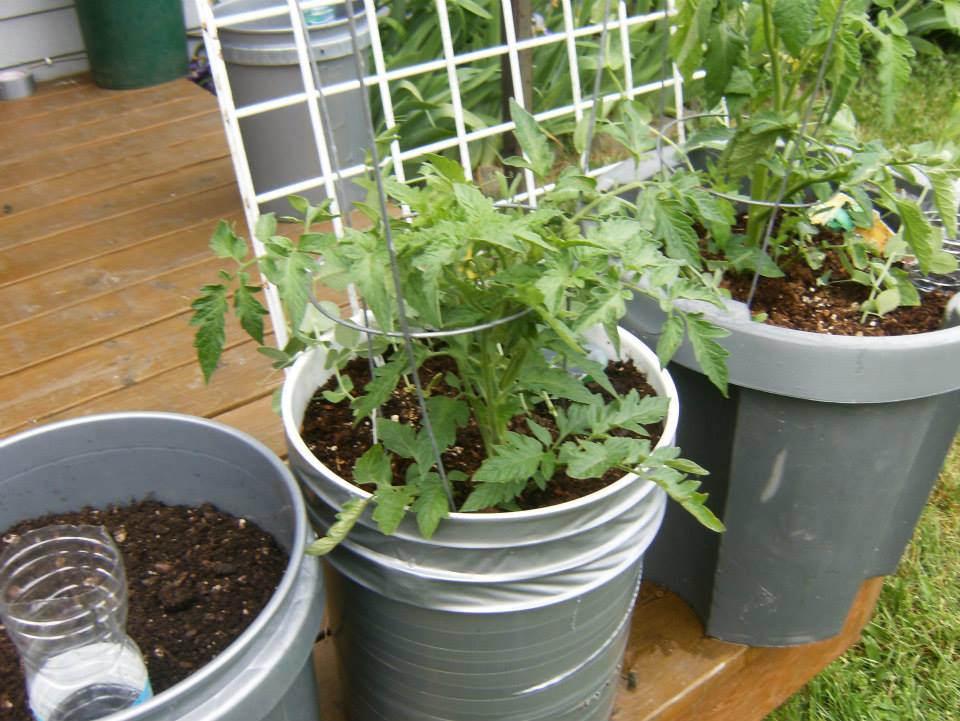
Nurturing and caring for tomato plants in buckets is a rewarding journey that requires attention and dedication. To ensure the health and vitality of your tomato plants, it’s essential to implement effective watering, fertilization, and pest prevention techniques. Let’s delve into these crucial aspects of bucket gardening and discover how to provide the best care for your thriving tomato plants.
Watering Strategies to Maintain Moisture Balance
- Consistent Moisture: Tomatoes thrive when their roots receive consistent moisture. Keep the soil in your buckets evenly moist, but not soggy. Avoid allowing the soil to dry out completely, as this can stress the plants and lead to blossom-end rot.
- Watering Time: Aim to water your tomato plants in the morning, allowing the foliage to dry before evening. Wet foliage at night can create a conducive environment for diseases to develop.
- Water at the Base: Direct your watering efforts at the base of the plants rather than sprinkling water over the foliage. This guarantees that the water is delivered to the essential root areas where it is most required.
- Use a Saucer: Place a saucer or tray under each bucket to catch excess water. This prevents water from draining onto your patio or balcony and allows the plant to access any excess moisture as needed.
Fertilization Techniques for Healthy Growth
- Choose the Right Fertilizer: Select a balanced, water-soluble fertilizer with equal amounts of nitrogen, phosphorus, and potassium. This formulation provides essential nutrients for healthy tomato growth.
- Start Fertilizing: Begin fertilizing your tomato plants when they start flowering. This is when they need additional nutrients to support fruit development.
- Follow the Instructions: Always follow the recommended dosage and application instructions provided on the fertilizer packaging. Over-fertilizing can harm the plants and lead to nutrient imbalances.
- Fertilize Regularly: For container-grown tomatoes, it’s crucial to fertilize more frequently than those grown in the ground. Every two to three weeks, apply a diluted solution of fertilizer to keep the plants well-nourished.
Preventing Common Pests and Diseases in Bucket Gardening
- Choose Disease-Resistant Varieties: When selecting tomato varieties, opt for those with resistance to common diseases like blight and wilt. Disease-resistant varieties can significantly reduce the risk of plant infections.
- Maintain Cleanliness: Regularly remove fallen leaves and debris from the soil surface to prevent the buildup of pathogens and pests.
- Inspect Regularly: Routinely inspect your tomato plants for any signs of pests or diseases. Early detection allows for prompt treatment and prevents the spread of issues.
- Natural Pest Control: Consider using natural pest control methods, such as introducing beneficial insects or using neem oil, to combat pests without harmful chemicals.
Harvesting Tomato Plants In Buckets
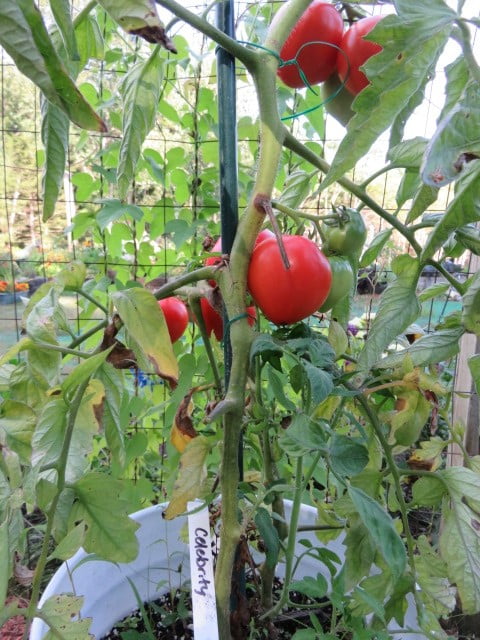
Harvesting the fruits of your labor in the bucket garden is a moment of satisfaction and joy. When the time comes to reap the rewards of your hard work, it’s essential to know the signs of tomato readiness for harvest, the proper harvesting techniques, and the delightful recipes that will allow you to savor the delicious flavors of your homegrown tomatoes. Let’s explore how to make the most of your tomato harvest and enjoy the fruits of your gardening efforts.
Signs of Tomato Readiness for Harvest
- Color Change: The most apparent sign that your tomatoes are ready for harvest is a change in color. Depending on the variety, tomatoes may turn red, yellow, orange, or other hues when they are ripe.
- Firmness: Gently squeeze the tomato; a ripe tomato should be firm but yield slightly to pressure. Avoid harvesting tomatoes that are too hard or too soft.
- Full Size: Ripe tomatoes reach their full size, but some varieties may still be delicious when slightly smaller. Know the expected size of your chosen tomato variety to gauge ripeness.
- Easy Twist: For certain varieties like cherry tomatoes, you can gently twist the fruit off the vine when it’s ready for harvest.
Tips for Properly Harvesting Tomatoes
- Use Pruning Shears: To harvest larger tomatoes, use clean pruning shears or a sharp knife to cut the fruit from the stem. This prevents damage to the plant and ensures a clean cut.
- Leave the Calyx: Leave the green calyx (the part that attaches the tomato to the stem) intact when harvesting. This helps preserve the tomato’s freshness and prevents disease entry points.
- Handle with Care: Be gentle when harvesting to avoid bruising or damaging the tomatoes. Handle them delicately to maintain their quality.
Troubleshooting FAQs for Growing Tomatoes in Buckets
How often should I water my tomato plants in buckets?
Water tomato plants in buckets regularly to keep the soil evenly moist. Check the top inch of soil and water when it feels dry. Adjust the watering schedule based on weather conditions.
Can I use regular garden soil in my bucket for growing tomatoes?
While regular garden soil can be used, it’s best to use a well-draining and nutrient-rich soil mix for containers. Consider a blend of peat moss, perlite, and compost.
How can I protect my tomato plants from extreme weather conditions?
Protect tomato plants from extreme weather. Provide shade in hot weather and cover plants during cold snaps. Consider moving buckets to a sheltered location during adverse conditions.
Should I prune tomato plants grown in buckets?
Pruning is optional and depends on the tomato variety. Determinate tomatoes require less pruning, while indeterminate varieties may benefit from selective pruning to focus energy on fruit production.
Conclusion
With the best way to grow tomatoes in buckets, you can transform a small space into a thriving tomato garden. By following the tips and techniques outlined in this guide, you’ll be on your way to maximizing yield and enjoying the delicious rewards of your labor. Remember to choose the right buckets, provide the necessary care, and select the ideal tomato varieties for bucket gardening success. Embrace the versatility and convenience of growing tomatoes in buckets, and let your green thumb flourish with abundant harvests year after year.
